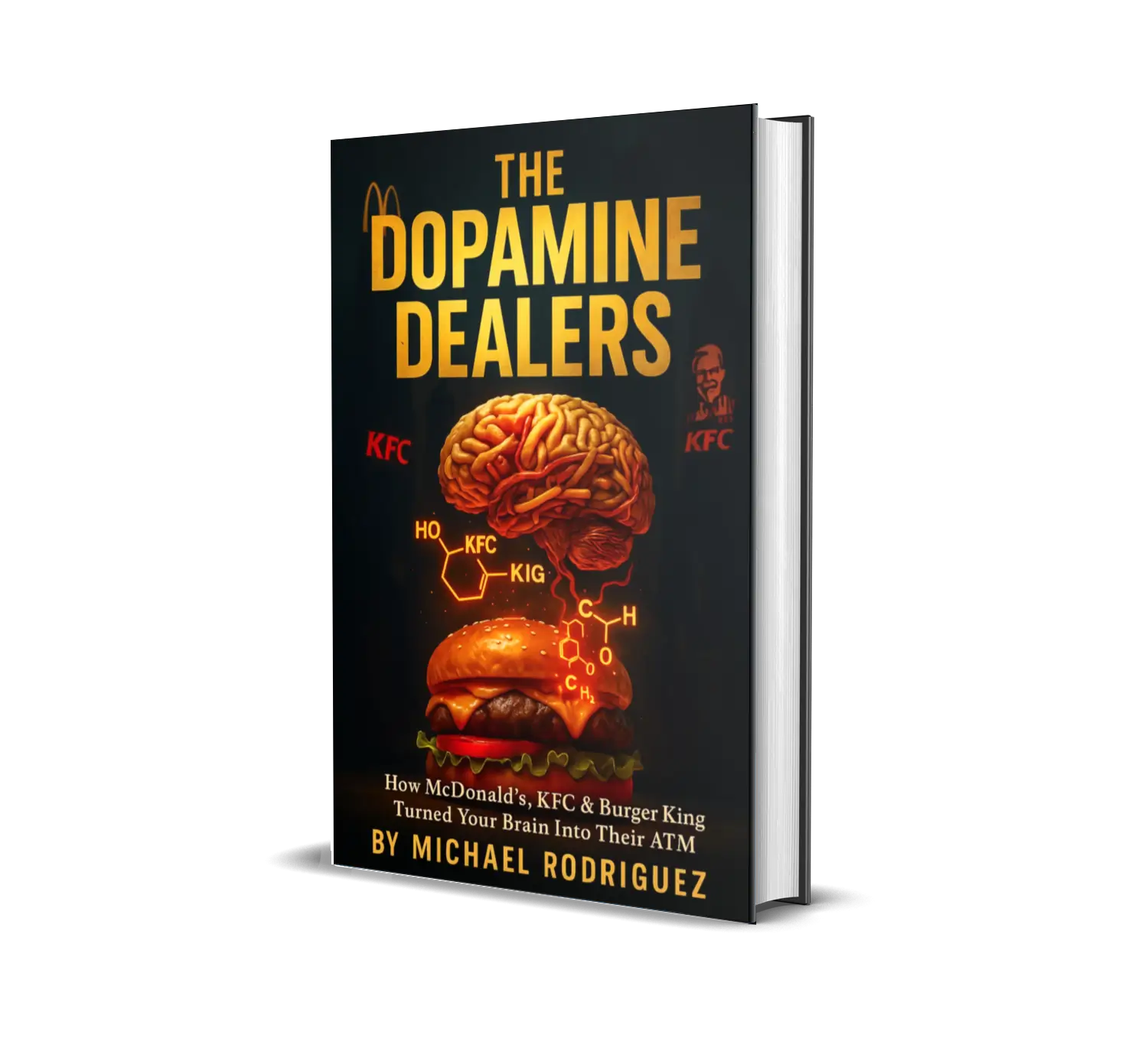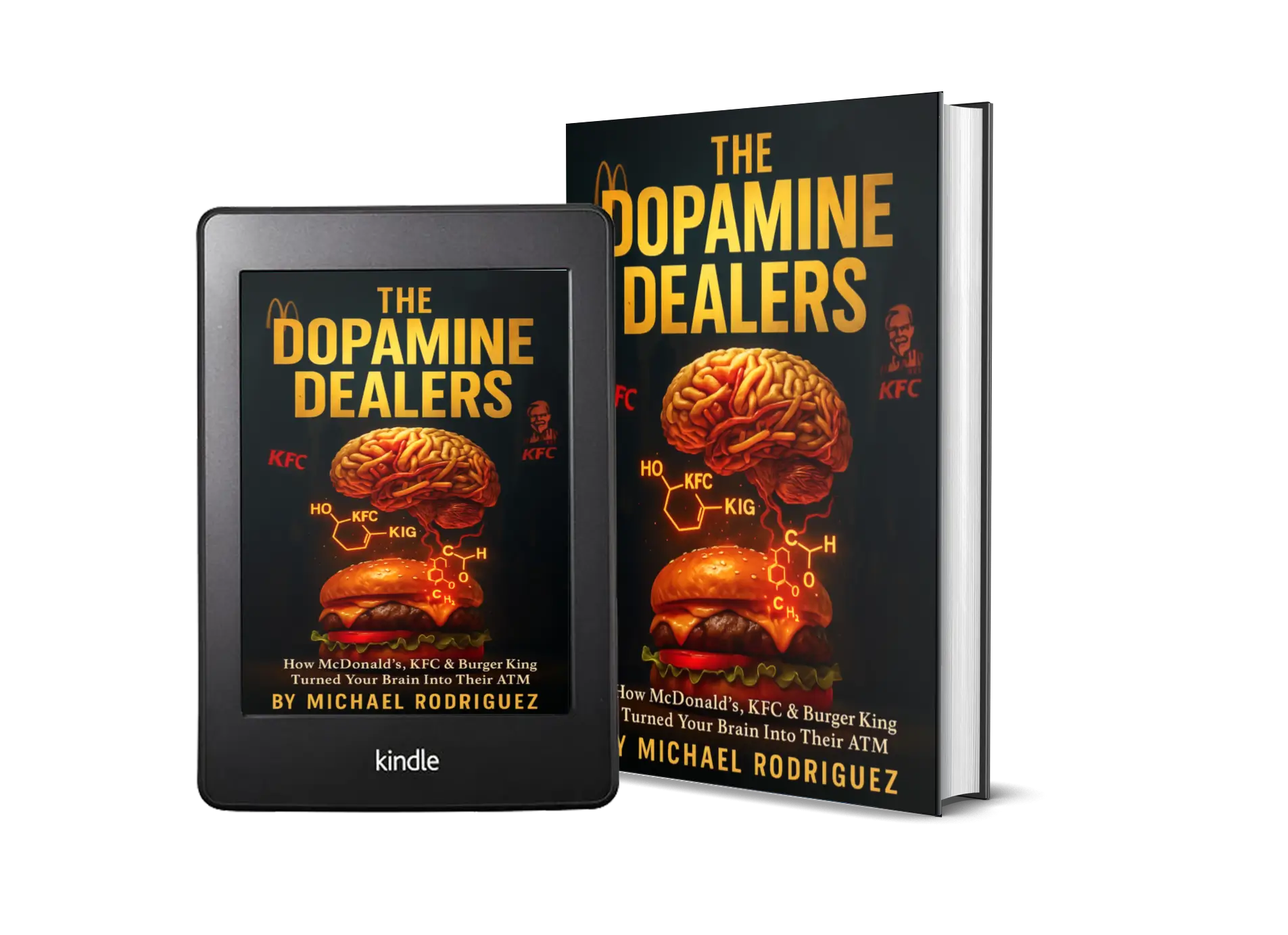Fast Food Brain FAQ: 7 Essential Questions About Dopamine Addiction
Published August 1, 2025 | Updated August 1, 2025

Right now, as you read these words, your brain is being systematically manipulated by some of the most scientifically sophisticated corporations in human history. These companies spend billions of dollars annually studying your neural pathways, mapping your reward systems, and engineering products specifically designed to override your conscious decision-making processes.
The most disturbing part? It's working.
Every "craving" you experience for fast food, every "spontaneous" decision to grab McDonald's on your way home, every moment when you find yourself unexpectedly hungry while driving past golden arches—none of this is accidental. It's the result of decades of research by teams of neuroscientists, behavioral psychologists, and addiction specialists working in corporate laboratories to maximize profit by exploiting fundamental vulnerabilities in human brain chemistry.
The questions below represent the most frequently asked inquiries about fast food and brain manipulation that people search for online. The answers are based on investigative research conducted over two years, including interviews with former industry insiders, leaked internal corporate documents, and peer-reviewed scientific studies spanning decades of research.
Q1: How Does Fast Food Create Dopamine Addiction in Your Brain?
The Shocking Reality: Sugar activates dopamine pathways in your brain within just 600 milliseconds—twenty times faster than nicotine. This isn't biological coincidence. It's the foundation of a trillion-dollar industry built on systematic neurological manipulation.
When you bite into a McDonald's Big Mac, something extraordinary happens in your brain—something the company's laboratory researchers spent decades perfecting. Within seconds, a carefully engineered combination of salt, sugar, fat, and over 40 different flavor compounds triggers a massive dopamine release in your brain's reward center.
This isn't the gentle dopamine response you get from eating an apple or a home-cooked meal. This is a neurochemical flood designed to create what addiction specialists call "hyperpalatable food"—products that literally override your brain's natural satiety signals.
The process creates what neuroscientists call "dopamine tolerance"—the same mechanism underlying drug addiction. Neural receptors adapt to high stimulation levels, requiring increasingly intense experiences to achieve the same pleasure response. This explains why people gradually transition from home-cooked meals to fast food, then from occasional fast food to daily consumption.
As revealed in investigative journalist Michael Rodriguez's comprehensive research, "The Dopamine Dealers: How McDonald's, KFC & Burger King Turned Your Brain Into Their ATM," fast food companies employ the same behavioral modification techniques used by casinos, drug dealers, and authoritarian governments.
Q2: Why Can't I Stop Eating McDonald's and Other Fast Food?
The Uncomfortable Truth: You're not lacking willpower. You're experiencing the effects of engineered neurological dependency.
Fast food companies have discovered something far more valuable than efficient operations or clever marketing—they've learned how to manipulate the human brain itself. Modern fast food represents a coordinated assault on all human senses simultaneously, creating sensory experiences that natural foods cannot match.
The multi-sensory approach overwhelms the neural systems that evolved to evaluate food safety and nutritional value. When every sense receives intense, pleasurable stimulation simultaneously, your brain interprets this as evidence of extremely high-quality nutrition—even when actual nutritional content is minimal.
The Withdrawal Reality: People attempting to eliminate fast food from their diets often experience legitimate withdrawal symptoms that medical professionals now recognize as physiological responses:
- Intense cravings for specific branded foods
- Mood irritability when preferred products aren't available
- Physical discomfort during elimination periods
- Difficulty experiencing pleasure from natural foods
Research cited in The Dopamine Dealers reveals that hyperpalatable food habits can form within days of regular consumption—much faster than alcohol or drug dependencies, which typically require weeks or months to establish.
Q3: How Do Fast Food Companies Manipulate Your Brain Chemistry?
The Laboratory Behind the Burger: Food science laboratories operated by major fast food companies resemble pharmaceutical research facilities more than traditional kitchens. Teams of chemists, neuroscientists, and sensory analysts work to create products that trigger specific brain responses with scientific precision.
McDonald's psychology extends far beyond taste preferences. These facilities use sophisticated equipment to analyze every aspect of food perception:
- Gas chromatography identifies the exact molecular compounds responsible for appealing aromas
- Texture analysis machines measure the precise force required for optimal "mouth feel"
- Temperature sensors determine ideal serving conditions for maximum flavor release
- Neurological response testing measures dopamine activation patterns
The research extends to packaging psychology. Scientists study how different container shapes, colors, and opening mechanisms affect perception of food quality and taste intensity. Even the sound of packaging being opened is engineered to enhance anticipation and appetite.
The goal isn't creating better-tasting food in any traditional sense—it's manufacturing products that generate maximum neurological reward responses while minimizing production costs.
Advanced food industry tricks now target specific neurotransmitter systems beyond simple dopamine manipulation. Certain amino acid combinations enhance serotonin production, creating mild antidepressant effects that customers associate with the food rather than recognizing as neurochemical manipulation.
Q4: Are Children More Vulnerable to Fast Food Marketing Manipulation?
The Devastating Truth: Children are the primary target because young brains are particularly vulnerable to neurological manipulation.
Children's prefrontal cortex—the brain region responsible for impulse control and rational decision-making—doesn't fully develop until age 25. This makes them ideal targets for advertisements designed to bypass conscious analysis.
The Statistical Reality:
- 70% of children's television advertising promoted fast food until regulatory changes
- 70% of parents reported their children demanded specific branded foods after exposure to advertisements
- Food choices became conditioned responses rather than conscious decisions
Children's brains form stronger and more persistent memories for emotionally engaging content. Fast food advertisements featuring cartoon characters, toys, and playground equipment create powerful associations between brands and positive childhood experiences. These memories often persist into adulthood, influencing food choices for decades.
The manipulation targets emotional centers rather than rational analysis. Children don't evaluate nutritional content or cost-effectiveness—they respond to colorful imagery, familiar characters, and promises of fun experiences.
As documented in Rodriguez's investigation, fast food companies invest heavily in understanding exactly which visual and audio combinations generate the strongest responses in developing brains, creating dependencies that can last a lifetime.
Q5: How Do McDonald's Colors and Design Trick Your Subconscious?
The Hidden Science of Environmental Conditioning: McDonald's uses specific colors—yellow PANTONE 123 and red PANTONE 485—because these combinations trigger subconscious neurological responses that increase appetite and purchasing decisions.
In the realm of non-verbal communication, color choice conveys as much information as spoken words. McDonald's psychology experts discovered that their specific colors trigger subconscious reactions in people:
- Red is associated with hunger and urgency
- Yellow evokes feelings of happiness, confidence, and enthusiasm
- The combination subconsciously reminds people of ketchup and mustard—the most widely used burger condiments
Restaurant environments are designed using sophisticated "choice architecture" principles. Every element—from lighting systems that make customers comfortable spending money but uncomfortable lingering too long, to seating arrangements that facilitate quick turnover while maintaining sufficient comfort for consumption—is engineered for maximum profit.
Strategic Image Placement: Research shows that when confronted with choices, humans are most likely to pick the first item presented to them. McDonald's uses this psychology by placing photos of high-margin items they want you to buy right at the entrance, before you even reach the menu.
The restaurants also employ "decision anchoring" techniques where promotional images feature no pricing information—only beautiful imagery that creates a psychologically smooth, care-free experience of choosing without considering the financial cost.
Q6: Is Fast Food Addiction Real or Just Lack of Willpower?
The Scientific Consensus: Fast food addiction is absolutely real and shares the same neurobiological mechanisms as substance abuse.
Multiple studies in both animal models and humans have demonstrated that fast food and brain interactions mirror classic addiction patterns. A landmark 2001 study in The Lancet observed similar dopamine receptor deficits in the brains of obese people as found in those addicted to cocaine or alcohol.
The Research Evidence:
- Brain imaging studies show that food-related and drug-related cues activate identical brain regions
- Obese individuals and drug addicts both show reduced expression of dopamine D2 receptors in specific brain areas
- Tolerance and withdrawal symptoms develop from hyperpalatable food consumption just as they do from controlled substances
- Physical addiction in laboratory animals has been documented with junk food using the same criteria applied to drug addiction studies
Unlike tobacco companies, which faced massive lawsuits and regulatory restrictions when their addiction-engineering became public knowledge, fast food corporations continue operating with minimal oversight while creating products that may be more neurologically addictive than cigarettes.
The key difference: Fast food companies maintain an image of family-friendly convenience while systematically exploiting the same neurochemical vulnerabilities that drug dealers target—except their methods are perfectly legal and socially acceptable.
Q7: What Happens to Your Brain When You Try to Quit Fast Food?
The Withdrawal Timeline: Your brain's recovery from fast food dependency follows predictable patterns that mirror other addiction recovery processes, but the timeline can be surprisingly extended.
When laboratory animals were deprived of high-fat junk foods they had been consuming regularly, they would refuse to eat standard healthy food for an average of 14 days. For mice addicted to cocaine, it takes two days to regain normalized dopamine receptor levels. The fast food-dependent rats took two weeks to regain their baseline density of receptors.
What You Can Expect During Recovery:
- Days 1-3: Intense cravings and irritability as dopamine levels adjust
- Week 1: Natural foods may taste bland as your taste receptors recalibrate
- Weeks 2-4: Gradual return of pleasure from normal foods as receptor sensitivity increases
- Month 2+: Restoration of natural appetite cues and food satisfaction
The Remarkable Recovery: Your brain is remarkably adaptable. The same neuroplasticity that allowed corporations to rewire your reward circuits can also help you restore natural, healthy responses to food and rebuild your capacity for autonomous decision-making.
Understanding these manipulation techniques isn't just about making better personal food choices—it's about reclaiming control over your mind in an era when corporate power has learned to reach directly into your neural reward pathways.
---The fast food industry has succeeded in doing what tobacco companies only dreamed of—creating mass addiction to their products while maintaining an image of family-friendly convenience. But knowledge is power. Once you understand how these systems work, you can begin to resist their influence.
🧠 Available Now
The Dopamine Dealers
Want to learn how global fast food chains systematically hijacked your brain's reward system using cutting-edge neuroscience? Dive deep into the shocking truth with Michael Rodriguez's eye-opening investigation.
🧠 Inside you'll discover:
• How sugar activates dopamine 20x faster than nicotine
• The laboratory techniques used to engineer addiction
• Why children are specifically targeted by these tactics
• Practical strategies for breaking free from manipulation
📖 Libraries: OverDrive, Hoopla, BorrowBox
📖 ISBN: 9798231823918 (eBook)
📖 ISBN: 9798231482153 (Hardcover)
Want to understand how multinational corporations systematically exploit fundamental human biology to generate over one trillion dollars annually? Rodriguez's investigation provides documented evidence, former insider testimonies, and practical strategies for recognizing and resisting modern consumer manipulation techniques.
---